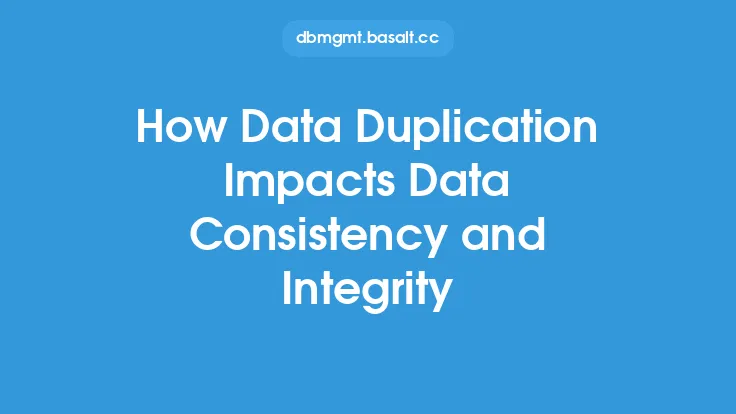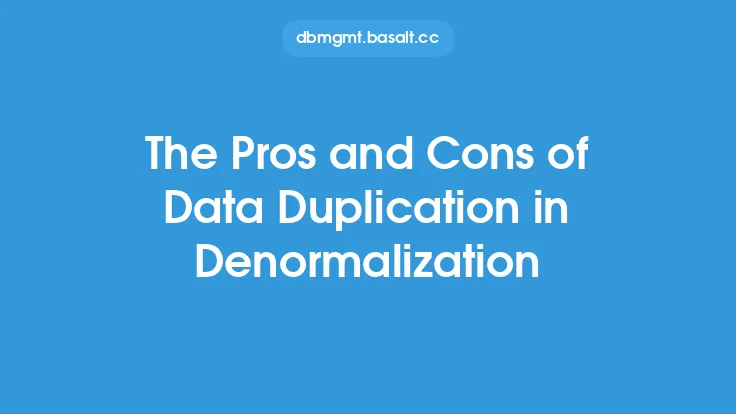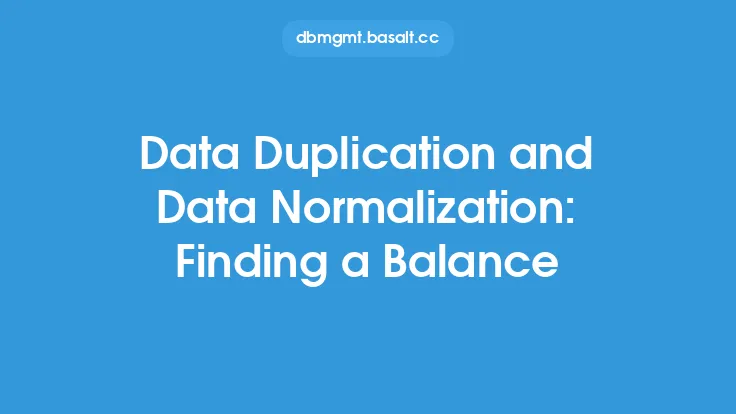Data duplication, in the context of data denormalization, refers to the process of intentionally storing redundant data in a database to improve performance, reduce complexity, or enhance data accessibility. This technique is often employed in database design to optimize query performance, reduce join operations, and improve data retrieval efficiency. However, data duplication also raises concerns about data governance, as it can lead to data inconsistencies, inconsistencies, and integrity issues if not managed properly.
Introduction to Data Governance
Data governance refers to the set of policies, procedures, and standards that ensure the accuracy, completeness, and consistency of data within an organization. It involves the management of data quality, data security, and data compliance, as well as the establishment of data standards, data classification, and data retention policies. Effective data governance is critical in ensuring that data duplication does not compromise the integrity of the data, and that the benefits of data duplication are realized without introducing unnecessary risks.
Considerations for Data Duplication
When considering data duplication, several factors must be taken into account. First, the type of data being duplicated must be evaluated. Data that is frequently accessed, updated, or used in complex queries may be good candidates for duplication. However, data that is sensitive, confidential, or subject to regulatory compliance may require additional security measures or alternative approaches. Additionally, the volume of data being duplicated, the frequency of updates, and the storage requirements must be assessed to ensure that the benefits of duplication outweigh the costs.
Implications of Data Duplication on Data Governance
Data duplication can have significant implications on data governance, particularly in terms of data quality, data security, and data compliance. When data is duplicated, it can lead to inconsistencies and discrepancies between the original and duplicated data, which can compromise data integrity. Furthermore, duplicated data may be subject to different security controls, access permissions, and retention policies, which can increase the risk of data breaches, unauthorized access, or non-compliance with regulatory requirements. Therefore, it is essential to establish robust data governance policies and procedures to manage data duplication, ensure data consistency, and maintain data integrity.
Technical Approaches to Data Duplication
From a technical perspective, data duplication can be achieved through various approaches, including materialized views, data warehousing, and data caching. Materialized views involve storing the result of a query in a physical table, which can be updated periodically to reflect changes to the underlying data. Data warehousing involves storing data in a separate database or repository, optimized for querying and analysis. Data caching involves storing frequently accessed data in memory or a fast-access storage device to reduce the latency of data retrieval. Each of these approaches has its advantages and disadvantages, and the choice of approach depends on the specific use case, data requirements, and system architecture.
Data Duplication and Data Storage
Data duplication also has implications for data storage, as it can increase the overall storage requirements of a database or system. When data is duplicated, it can lead to an increase in storage capacity, which can result in higher costs, increased complexity, and reduced system performance. Therefore, it is essential to carefully evaluate the storage requirements of duplicated data and to consider strategies for optimizing storage capacity, such as data compression, data deduplication, or storage virtualization.
Data Duplication and Data Retrieval
Data duplication can also impact data retrieval, as it can improve query performance and reduce the latency of data access. When data is duplicated, it can be stored in a format that is optimized for querying, such as a denormalized table or a materialized view. This can reduce the complexity of queries, eliminate the need for join operations, and improve the overall performance of the system. However, data duplication can also introduce additional complexity, as it requires mechanisms for updating and synchronizing the duplicated data, which can add overhead and reduce system performance.
Conclusion
In conclusion, data duplication is a powerful technique for improving performance, reducing complexity, and enhancing data accessibility in database design. However, it also raises concerns about data governance, as it can lead to data inconsistencies, inconsistencies, and integrity issues if not managed properly. By understanding the considerations and implications of data duplication, organizations can establish effective data governance policies and procedures to manage duplicated data, ensure data consistency, and maintain data integrity. Additionally, by leveraging technical approaches to data duplication, such as materialized views, data warehousing, and data caching, organizations can optimize data storage, improve data retrieval, and realize the benefits of data duplication while minimizing the risks.





